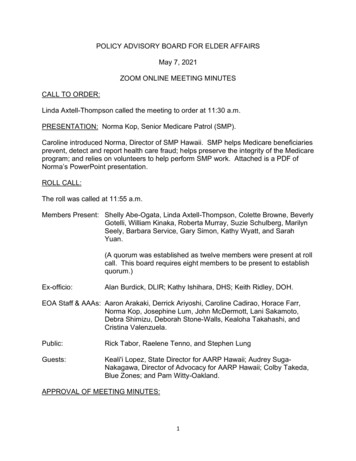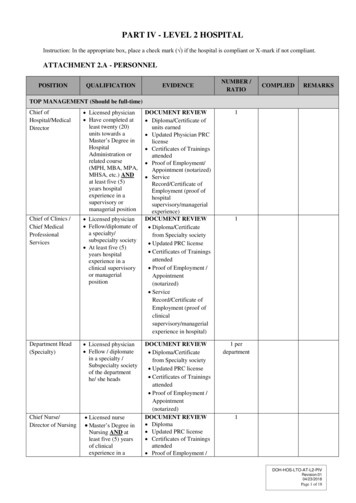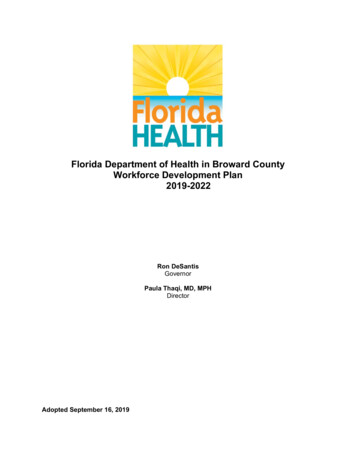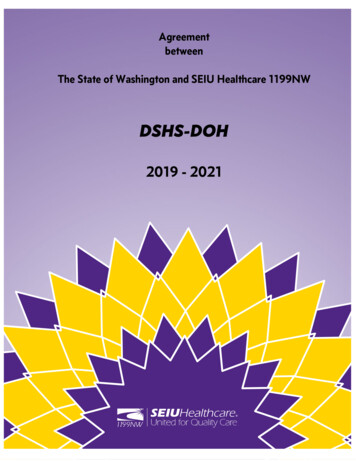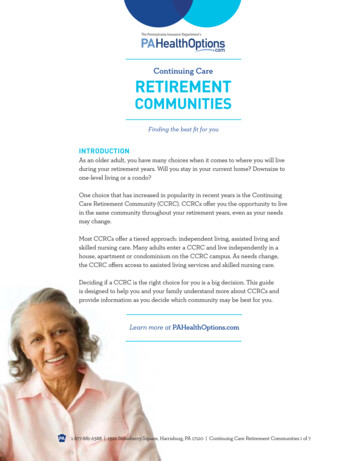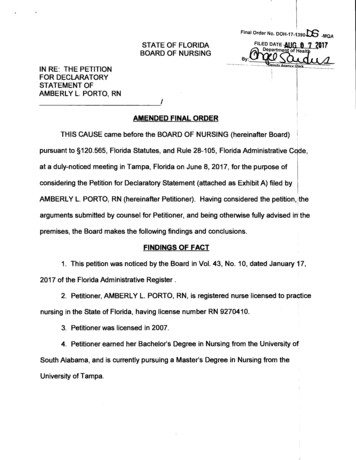
Transcription
Final Order No. DOH-17-1390.W -MQASTATE OF FLORIDABOARD OF NURSINGFILED DATE AI a AL/2017Department of LlealtB:IN RE: THE PETITIONFOR DECLARATORYSTATEMENT OFAMBERLY L. PORTO, RNAMENDED FINAL ORDERTHIS CAUSE came before the BOARD OF NURSING (hereinafter Board)pursuant to §120.565, Florida Statutes, and Rule 28-105, Florida Administrative Cs:lde,at a duly-noticed meeting in Tampa, Florida on June 8, 2017, for the purpose ofconsidering the Petition for Declaratory Statement (attached as Exhibit A) filed byAMBERLY L. PORTO, RN (hereinafter Petitioner). Having considered the petition, thearguments submitted by counsel for Petitioner, and being otherwise fully advised in thepremises, the Board makes the following findings and conclusions.FINDINGS OF FACT1. This petition was noticed by the Board in Vol. 43, No. 10, dated January 17,2017 of the Florida Administrative Register .2. Petitioner, AMBERLY L. PORTO, RN, is registered nurse licensed to practicenursing in the State of Florida, having license number RN 9270410.3. Petitioner was licensed in 2007.4. Petitioner earned her Bachelor's Degree in Nursing from the University ofSouth Alabama, and is currently pursuing a Master's Degree in Nursing from theUniversity of Tampa.
5. In 2008, Petitioner completed End-of-Life Nursing Consortium training, a 25hour education program in pain and symptom management and other aspects ofpalliative care.6. Petitioner was certified as a Medical Surgical Registered Nurse in 2013.7. Petitioner focuses her clinical practice on adult medical surgical and palliativecare for patients who qualify for in-patient palliative care at Tampa General Hospital,and has nearly 10 years experience working with palliative care patients.8. Petitioner inquires if it is within the scope of her practice to administer 0.5mg/kg or less of ketamine intravenously or intramuscularly for analgesia to end-stagepatients receiving palliative care who suffer from pain that is chronic, intractable ordifficult to control as an alternative to, or adjunct to, opioids.9. The administration of ketamine would be pursuant to an order by a licensedphysician or advanced registered nurse practitioner under policies and proceduresestablished by an inter-disciplinary team at Tampa General Hospital.10. The hospital pharmacy will prepare the dosage for administration.CONCLUSIONS OF LAW1. The Board has jurisdiction over this matter pursuant to § 120.565, FloridaStatutes, and Rule 28-105, Florida Administrative Code.2. The petition filed in this cause is in substantial compliance with the provisionsof § 120.565, Florida Statutes, and Rule 28-105, Florida Administrative Code.3. The scope of practice of a registered nurse is defined in § 464.003(20),Florida Statutes, to include:
The administration of medications and treatments as prescribed orauthorized by a duly licensed practitioner authorized by the laws of thisstate to prescribe such medications and treatments.WHEREFORE, the Board hereby finds that under the specific facts of thepetition, as set forth above, it is within the scope of the education, training andexperience of Petitioner to administer 0.5 mg/kg does of ketamine to palliative care,patients for analgesic purposes.DONE AND ORDERED this 14 day ofBOARD OF NURSINGC-----Joe R.Jody BryanJr.for forman, EdD, EdS, ChairNOTICE OF APPEAL RIGHTSPursuant to § 120.569, Florida Statutes, the parties are hereby notified that theymay appeal this Final Order by filing one copy of a notice of appeal with the clerk of thedepartment and by filing a filing fee and one copy of a notice of appeal with the DistrictCourt of Appeal within thirty days of the date this Final Order is filed.CERTIFICATE OF SERVICEI HEREBY CERTIFY that a true and correct copy of the foregoing Final Orderhas been furnished by U.S. Mail to Cynthia A. Mikos, Esquire, 401 East Jackson Street,Suite 3100, Tampa FL 33602, and by email to Donna Oxford,Donna.Oxforde.myfloridalegal.com thissctSrday of s, 2017.SakdiaDeputy Agency Clerk
TO:Adrienne C. Rodgers, ChiefBureau of Health Care Practitioner RegulationFROM:Joe Baker, Jr., Executive DirectorFlorida Board of NursingDATE:August 1, 2017RE:Delegation of AuthorityDuring my absence this afternoon through Friday, August 4, 2017, the followingmanagers are delegated authority for the board office:8/1-28/3-4Thank you.JBjemsVickie BoydKathy HerronRegulatory SupervisorRegulatory Supervisor
FILEDDEPARTMENT OF HEALTHDEPUTY CLERKCLERK Anael SandersDATE kFLORIDA DEPARTMENT OF HEALTHBOARD OF NURSINGPetition for Declaratory StatementBefore the Board of NursingRECEIVEDIn re: Amberly L. Porto, RNDEP/ \ 1-‹ I IVILN I Ur t-IAL TtPetitioner, Amberly L. Porto, RN, by and though the undersigned attorneys and purswantto Florida Statutes § 120.565 and Florida Administrative Code Rule 28-105, seeks the FloOdaBoard of Nursing's ("Board") opinion as to whether the intravenous or intramuscularadministration of low dose ketamine for purposes of analgesia in a palliative care setting iSwithin her scope of practice as a registered nurse.1.Petitioner, Amberly L. Porto, is a registered nurse licensed by the Florida Boardof Nursing pursuant to Florida Statutes Chapter 464 holding license number RN 9270410since2007. She can be contacted through undersigned counsel.2.Ms. Porto is currently employed at Tampa General Hospital ("TGFI") as aClinician in the Acute Care Division on the Complex Medicine Unit, where she has practicedsince 2008.3.After earning a Bachelor's Degree in Biology from the University of Georgia, Ms.Porto went on to graduate with honors from the Universityof South Alabama, earning a secondBachelor's Degree in Nursing in 2007. Ms. Porto is now working towards her Master's Degreein Nursing at the University of Tampa and she is on track to graduate in 2019.4.In 2008, Ms. Porto completed End-of-Life Nursing Education Consortium("ELNEC") Training, a 25-hour educational program that provides training in pain andsymptommanagement, communication strategies, spiritual support, care at the end of life, ethics, and other1
aspects of palliative care. In addition, she has been certified as a Medical Surgical RegiSteredNurse since 2013. A copy of Ms. Porto's curriculum vitae is attached as Exhibit I.5.Ms. Porto focuses her clinical practice on Adult Medical Surgical & PalliativeCare, rendering patient care and assisting other nursing staff to care for patients who qua)ify forpalliative care including those housed in the three Palliative Care Suites located in the ComplexMedicine Unit. TGH's Palliative Care Suites provide a private setting with home-like comfortsfor patients suffering from terminal illness who require inpatient care. One of her roles includesproviding direct patient care and clinically supervising other nurses in the Acute Care Division.6.Ms. Porto seeks the Board's determination as to whether it is within her scope ofpractice as a registered nurse to administer 0.5 mg/kg or less of ketamine intravenously orintramuscularly for patients receiving palliative care who suffer from pain that is chronic,intractable, or difficult to control as an alternative to, or adjunct to, opioids. This administraitionof ketamine would be conducted pursuant to an order by a duly licensed practitioner and inaccordance with policies and procedures established by TGH. At no time would Ms. Portoadminister ketamine at a dose that is deemed to be general anesthesia.7.Ketamine is approved by the United States Food and Drug Administration as anonbarbiturate anesthetic producing an anesthetic state characterized by profound analgesia,normal pharyngeal-laryngeal reflexes, cardiovascular and respirator/ stimulation, andoccasionally a transient and minimal respiratory depression. Ketamine is noted for its ability toproduce a state of anesthesia while preserving respiratory drive and protective airway reflexes.8.In low or subdissociative doses ketamine has been shown to confer "potent,analgesic and amnestic effects that are accompanied by preservation of protective airwayRakic and Golembiewski,Low-Dose Ketamine Infusion for Postoperative Pain Management,PeriAnesthesia Nursing, 254,254 (August 2009).242Journal of
responses, spontaneous respiration and cardiopulmonary stability."2Analgesic dosages ofketamine are generally less than 1.0 mg/kg and are commonly referred to as low dose ketamine.IcyIn low doses, ketamine has shown opioid-sparing effects which have made it a useful agentin many situations, including for pain relief post-operatively, in palliative care settings, and forpatients with a tolerance to opioids. It is especially helpful when seeking to avoid the respiratorydepression associated with the use of opioids and benzodiazepines. A multitude of trials andstudies have borne out the efficacy of low dose ketamine in palliative care, resulting in itswidespread use in such settings. Eric E. Promrner, M.D.'s articleof Uses in Palliative Care,Ketamine for Pain: An Updateattached hereto as Exhibit 2, provides a comprehensive overview ofthe modern role of ketamine in palliative care.9.In the Amended Final Order dated February 28, 2014 in In Re Petition forDeclaratory Statement of Lancia L. Simmons, RN,this Board approved Ms. Simmons'administration of low dose ketamine in the burn unit of TGH for pain control during time limitedprocedures such as dressing changes. During 2003, inIn Re Linda C. Noelke, RN, the Board'concluded that it was not within Ms. Noelke's scope of practice to administer ketamine forpurposes of rendering a patient insensible to pain in an ambulatory surgery center when noanesthesia provider was present. Here, Ms. Porto, like Ms. Simmons, seeks to administer lowdose ketamine for pain corm-of.10.The administration of ketamine by registered nurses ("RNs") has come beforeBoards of Nursing in other states where licensees have sought regulatory guidance. The NewYork and Oregon Boards of Nursing have specifically addressed the issue of ketamineMotov, Rockoff, Cohen, et al,Intravenous Subdissociative-Dose Ketamine Versus Morphine for Analgesia ineEmergency Department: A Randomized Controlled Trial,66 Annals of Emergency Medicine, 222-229 (September2015).3
administration by RNs and have issued policy statements which state it is within the scope ofpractice of registered nurses to administer low dose ketamine as long as specific criteria are met.The Texas Board of Nursing has discussed the issue and while it declined to specifically issue apolicy statement, it implies in its FAQs that it may be within the scope of practice for registerednurses with appropriate training and in appropriate settings to administer low dose ketarnine. TheState of Washington's Nursing Care Quality Assurance Commission in an Advisory Opiniondated 3-13-15 found that low-dose ketamine provides effective analgesia for the treatment ofpost-operative pain, neuropathic pain, and chronic pain, especially related to patients with opioidtolerance. The Washington board cited studies finding that use of ketamine results in a decreasein opioid requirements in surgical and non-surgical patients, fewer interventions to managesevere pain, a positive impact on knee immobilization after total knee arthroplasty, a decrease inpost-operative nausea and vomiting and reduced pain scores for as long as one-year aftersurgery. They concluded that an RN may administer analgesic, sedating and anesthetic agents foracute and chronic pain using low-dose anesthetics and for emergency care, including rapidsequence intubation under certain conditions. The Minnesota Board of Nursing in its Statementof Accountability for Administration of Medications Classified as Anesthetics by the RegisteredNurse adopted in October 2005 and reaffirmed in December of 2009 found that theadministration of medications classified as anesthetics, such as ketamine, for the purpose ofprocedural sedation and analgesia require particular attention by the RN, including specializedcompetencies and immediate availability of emergency personnel. The Wyoming State Board ofNursing in its Opinion: IV Administration of Low-Dose Ketamine for Pain in Adults datedOctober 10, 2013 and revised October 2016 found that it is within the scope of practice for anappropriately trained RN to administer and monitor low-dose ketamine infusion for the purpose4
of pain control. The Wyoming Opinion outlines that a ketamine infusion for pain relief should beinitiated in a nursing care unit with a low patient to nurse ratio, such as the emergencydepartment or palliative care area, by RNs with additional education, skills and demonstratedcompetence. The Nebraska Board of Nursing in its Advisory Opinion on Low-Dose Ketamineadopted June, 2014 and reaffirmed in April 2016 also approved the appropriately trained RN toadminister and monitor low-dose ketamine infusions for pain control. Arizona, Alaska andNevada have also issued opinions that RNs may administer low-dose ketamine for analgesia inselect situations.11.The scope of practice of a registered nurse is defined in Florida Statutes§464.003(20) as follows:"Practice of professional nursing" means the performance of thoseacts requiring substantial specialized knowledge, judgment, andnursing skill based upon applied principles of psychological,biological, physical, and social sciences which shall include, butnot be limited to:(a) The observation, assessment, nursing diagnosis, planning,intervention, and evaluation of care; health teaching andcounseling of the ill, injured, or infirm; and the promotion ofwellness, maintenance of health, and prevention of illness ofothers.(b) The administration of medications and treatments asprescribed or authorized by a duly licensed practitioner authorizedby the laws of this state to prescribe such medications andtreatments.(c) The supervision and teaching of other personnel in the theoryand performance of any of the acts described in this subsection.A professional nurse is responsible and accountable for makingdecisions that are based upon the individual's educationalpreparation and experience in nursing.5
12.Ms. Porto would administer ketamine at sub-anesthetic doses as prescribed prauthorized by a duly licensed practitioner authorized to prescribe it. Ms. Porto has been infhrmedthat TGH would develop policies and procedures approved by a multidisciplinary team,including representatives from pharmacy, medicine and nursing, whereby ketamine may beadministered to patients receiving palliative care under conditions with which Ms. Porto wouldcomply.ARGUMENT13.The Board of Nursing has discretion to determine if a particular set of facts, withrespect to a specific licensee, results in actions which are within the scope of practice of theregistered nurse.14.The registered nurse may administer medication pursuant to an order of a dulyauthorized practitioner. In the facts presented, Ms. Porto would administer ketamine pursuant tothe order of a duly authorized practitioner.15.The registered nurse is responsible and accountable for making decisions that arebased upon the individual's educational preparation and experience in nursing. Ms. Porto ha nearly 10 years of experience working with palliative care patients in the Complex MedicineUnit of a large, urban hospital. She is an End-of-Life Nursing Education Consortium PalliativeResource Nurse, a Certified Medical Surgical Registered Nurse, and will demonstrate hercompetence to safely administer ketamine should the Board approve this petition. Under thesecircumstances, Ms. Porto's educational preparation and experience in nursing support her abilityto administer ketamine in these limited situations.6
16.Ms. Porto will administer ketamine in low doses to patients for pain relief as partof a palliative care regimen. This administration of ketamine will be accomplished pursuant topolicies and procedures developed by the hospital. Ms. Porto will not administer ketamine as ananesthetic.17.This Board and multiple other boards of nursing across the country havedetermined that the administration of low-dose ketamine for analgesia is within the scope ofpractice of a registered nurse, like Ms. Porto, under conditions like those outlined herein.WHEREFORE, Ms. Porto respectfully requests that the Board issue a declaratorystatement opining that her administration of low dose ketamine to patients receiving palliativecare for analgesia is within her scope of practice as a registered nurse.Respectfullyn submitted,ON POPE BOKOR RUPPEL & BURNS,LLPCynthia A. Mikos, Esq.Florida Bar No.: 0984256401 E. Jackson Street, Suite 3100Tampa, FL 33602Tel: (813) 225-2500Fax: (813) 223-7118E-Mail: cynthiamQipfirm.comCERTIFICATE OF SERVICEI hereby certify that a true and correct copy of the fully executed foregoing instrument hasbeen furnished via email (lee ann gustafson(aoag.statell.us) and U.S. Mail to LeeAnn Gustafson,Office of the Attorney General, The Capitol, PL-01, Tallahassee, FL 32399 and via facsimile (850-7
487-9537) and U.S. Mail to the Florida Department of Health, Agency Clerk, 4052 Bald'CypressWay, Bin A02, Tallahassee, FL 32399 on this8day of January, 2017.
PORTO, AMBERLY15413 Fire Rock Place, Ruskin, FL 33573 1 (W) 813.844.3946 (C)706.372.0031 I aporto@tgh.orgEDUCATIONUniversity of South Alabama, Mobile, AlabamaBachelors of Science, NursingCum Laude2007University of Georgia, Athens, GeorgiaBachelors of Science, BiologyUniversity of Tampa, Tampa, FloridaMasters of Science, Nursing2002Area of Concentration: Family Nurse PractitionerExpected Graduation: 20192016-PresentEXPERIENCETampa General Hospital, Tampa, FloridaComplex Medicine Unit, 2008-PresentBusy 65 bed medical/surgical telemetry unit in alevelInternal Medicine. Direct patient care1 trauma center and teaching hospital. Dedicated floor for The University of South Floridadependent patients.with diverse populations of patients including HIV/AIDS, palliative care, peritoneal dialysis, and ventilatorClinical Areaof Focus: Adult Medical Surgical & Palliative CareClinicianDuties include:2012 — Present Supervise 120 staff members consisting Yearly evaluations for all staff members of registerednurses, patient care technicians, unit coordinators, and cardiac monitor techniciansSchedule for all staffDiscipline staff Chart auditsMonitoring compliance of unit for Joint Commission, OSHA, and AHCA standardsFollow-up of patient and family complaints or concernsStaff educationChart/case reviewsCompletion of Root Cause Analysis related to wounds Infections, and falls Interview and hiring of applicants Charge Nurse Staff NurseInterim Nurse ManagerClinical Nurse/Charge NurseMarch 2016 — August 2017Acute Care Rotation Nurse2008-20122007LICENSURE AND 013-present.Registered NurseBLS CertificationFL Licensure No. RN 9270410End-of-Life Nursing Education Consortium Palliative Care Resource NurseCertified Medical Surgical Registered Nurse
JOURNAL OF PALLIATIVE MEDICINEVolume 15, Number 4, 2012ft) Mary Ann Liebert,DOI: 10.10894pm.2011.0244Palliative Care ReviewsFeature Editor. Vyjeyanthi S. PerlyakoilKetamine for Pain: An Update of Uses in Palliative CareEric E. Prommer, M.D.AbstractKetamine is a lipophilic, general anesthetic. When given at subanesthetic doses, it also has been found to be aneffective analgesic, with efficacy in cancer-associated neuropathic pain, ischemic pain, and regional p4in syndromes. It can be administered orally, intravenously, subcutaneously, and topically, and interacts withseveralreceptors important in pain management, most importantly the N-methyl-D aspartate (NMDA) receptor.Blockade of the NMDA receptor is associated with reversal of opioid tolerance. Ketamine is metaboliZed viacytochrome P450 3A4, although no significant interactions have been reported. Ketamine is considered: one ofthe World Health Organization (WHO) essential drugs for the management of refractory pain.Introductionenantiomer is available in Europe. Ketarnine is a highly lipofor patients in the pallid tive philic and water-soluble general anesthetic with a rnoalecularpcare population. The World HealthOrganization(wei ht of 274.3 It is hi hlMN IS A COMMON EXPERIENCEhilic (lipid solubilit 5 to 10 timesanalgesic ladder is a useful concept for the management of that of thiopental) and easily crosses te blood-brain barrier?pain, with its use leading to successful analgesia approximately 90% of the time) In the context of opioid use, the conept NMDA receptor and chronic painof opioid responsiveness becomes important. Opioidresponsiveness can be defined by "degree of analgesia achievExcitatory synaptic transmission in the central nervous sysas the doseis titrated to an endpoint defined either by in ed tem is mediated by amino acids, most notable of which istolglutamate.9 Amino acids bind to either ionotropicerable side effects or the occurrenceof acceptable analgesia."2chartIn cases where opioid responsiveness becomes an issue, otl nets) or metabotropic (G coupled) receptors.9The three chiefmodalities must be considered. One of the most import her ionotropic receptors are the NMDA, alpha amino-3-hydroxy-5causes of decreasing opioid responsiveness is N-methyl- nt methyl-4-isoxazolepropionic add (AMPA), and kainate recepaspartate(NMDA) overactivity.2 The use of NMDA antagD- tors.9 The NMDA receptor is a transrnembrane protein that actsnists is advocated as a way of improving analgesia when p o- as an ion channel for Na 1-, Ca ", and K 4 ions,influepcingopioid responsiveness is identified.2 Ketamine, a potoor neuronal excitability. NMDA is a heterodirrier consistingcif twoNMDA antagonist, was developed in 1962 as an anesthetent subunits." Located throughout the nervous system, NMDAagent, and has been shown to have minimal effect on t tic receptors mirror opioid receptors in location." At resting statecardiovascular system or respiratory systems.' In 1990 t he the channel is inactive due to Mg' * blockade. When activtaed,first reports of subanesthetic uses of ketamirte were describehe the Mg' ions are released out of the channel and then Oa**,for cancer pain, with low doses showing efficacy for opioidd Na*, and K ions enter." Ca " influx is important for many ofresistant pain.9The purpose of this article is to review th - the intracellular processes that contribute to chronic pain s.pharmacodynamics, pharmacology, drug interactions, an e Calcium influx, through an activated NMDA receptor, qa tesbeaclinical uses of ketamine for pain. Methods of administratiod vates second-messenger systems, leading to a neuronal stateofand management of adverse effects will also ighted.12 NMDA activation is responsible for neuronal hyperexcitability, whicthisStructure/Chemistryclinically manifest as persistent hyperalgesia, spontaneouspain, allodynia, and radiation of pain.12Ketamine is a phencyclidine (PCP) derivative (Figure 1)Ketamine contains a chiral structure at the carbon # 2 position, Molecular changes due to Cal * influxallowing the formation of two isomers. In the United States,It is well established that activation of the NMDA receptorketamine is available as a racemic mixture that contains equalamounts of the two isomers S ( ) and R (-) forms. The S ( ) initiates intracellular processes that lead to problems wtithneuronal hyperexcitability.13Excitatory amino acids (EAA),—Division of Hematology/Oncology, Mayo Clinic College of Med- ---Accepted December 20, 2011.icine, Mayo Clinic Hospital Scottsdale, Arizona.474
KETAMINE FOR PAIN475S,( )-Ketamine hydrochlorideR,(—)-Ketamine hydrochlorideFIG. 1. S ( ) and R (—) ketamine.bind to the NMDA receptor and trigger the opening of calciumchannels," leading to other intracellular phenomena such asguanosine triphosphate mediated hydrolysis of phospholipids, and the generation of diacylglycerol and inositol 1,4,5triphosphate (IP3), both of which foster the further acctunulation of calcium in the cell. Diacylglycerol (DAG) also mediatesthe production of protein kinase C's which in turn generatesnitrous oxide production, which acts at the synapse to cause therelease of more excitatory amino acids.'6 A positive feedbackloop is created as more activation of the NMDA receptoroccurs because of the influx of excitatory amino acids. Activated protein kinase C diffuses to neuronal membranes andthis binding correlates with both hyperalgesia and opioidtolerance) Agents that block the translocation of proteinkinase C from cytosol to the neuronal membrane reducemorphine tolerance.'8Ketamine Receptor InteractionsKetamine interacts with several receptors that are important for pain management. The most important is the NMDAreceptor. Ketamine also interacts with ()plaid receptors, norepinephrine and serotonin transporters, and ion channels.NMDA receptorKetamine is described as a noncompetitive NMDA receptorantagonist, which means the drug requires an open channel soketamine can access its binding site in the c1annel.' 9 Ketaminehas a high affinity for the NMDA receptor with a Ki of 0.9 uMfor the S isomer and 2.5 uM for the R isomer."Oploid receptorsKetamine interacts with opioid receptors. S-ketamine hasaffinity nearly equivalent to that of morphine for the jc and 5opioid receptors, with Ki's of 28 uM and 24 uM, but weakeraffinity for the x opioid receptor." The R isomer has a weakerinteraction with opioid receptors, with Ki for the n, 5, and icopioid receptors of 83, 60, and 286 uM, respectively." Theanalgesic effect of ketamine is not reversed by naloxone, andthe contribution of ketamine's interaction with the opioidreceptors in the production of analgesia is not known?'Other receptorsKetamine has a weak action with muscarinic receptors withKi of 125 uM and 91 uM with the S and R isomers, respectively." Ketamine has weak interactions with dopamine,norepinephrine, and serotonin receptors. The affinity of ketamine for ion channels is weak."FormulationsKetamine is available as an intravenous solution, which canalso be administered orally, rectally, or intranasally." Whengiven orally, the intravenous formulation is used with a flavoradditive. Ketamine can be stored at room temperattire andcan maintain its potency for more than 30 days. S-ketainine isalso available in Europe as the commercially available pharmaceutical preparation and is also prepared in an aqueoussolution." Racemic ketamine is available in concentrations of10 mg/mL, 50 mg/in L, and 100 mg/mL.CompatibilityKetamine is compatible with midazolam when minced innormal saline. Ketamine is also stable when mixed withdexamethasone (low doses), haloperidol, opioids, ketorolac,and metoclopram id e.24Methods of Delivery and Modes of AdministrationKetamine has been administered for cancer pain by theoral, intravenous, and subcutaneous routes. The topical mutehas been evaluated for neuropathic pain. Ketamine is FDAapproved for intramuscular and intravenous administrationfor induction of anesthesia prior to administration of otheranesthetic agents."Pharmacology and routes of administrationThe bioavailability of ketamine varies according to theroute of administration. Intranasally, it is 25% to 50%, and theintramuscular bioavailablility is 93%.Orally administered ketamineThe oral bioavailability is 17%, and the onset of acticin ofketamine is 15 to 20 minutes. The half-life of ketamine is ?.5 to3.0 hours. Ketamine has protein binding of 20% to 30%.36Pharmacologically, there are no major differences in thecharacteristics between the isomers."Intravenous route/subcutaneous routeIntravenous onset of action is within seconds and subcutaneously the onset of action is 15 to 20 minutes.3 The halfl-lifeis two to three hours for both routes.3Intranasally administered ketamineWhen given by the intranasal route, ketamine has a WOavailability of 25% to 50%. Intranasal administration' of
o 4 ii 8 .,3.0o .c, ,VAes08 -' a. M ;P. (1/ Tr?,-,-oc .sc' .0'6' 01a.! 'lc, T0, .:.8,. .o .s -a ta-0 - .C .0 4., c - 6-, c'E0 A0 .R 0 .5.ti 6., a. 2 5 i-2 74 0, .g.-- a. 61' 0 41) a/ .Q M - a.}I5 0.CLI V. 2 Ni ,.E bcci.E. a) al Z. CleC C .1.1a, Y,t'l 'al 21:4 ai 1g -0. 8 1'.N/2- 6,,a, 2cm0g V8Routemethod1.1 g .E co0 2 12 45"0 u sr., .E4tnri 12 16 .7i , c t6 6 .k 0F .75 4'4;779000:1 T1 Ti.F.e t 18--13 1 6 v)CI' E 'M.564gics sgvg'6R -„?,'alo c esc.4 ? 0ra 0.cs)2 0. c - ,.Nm., ( co6:72 ,9.' a.e.1lcZ.5 o2 i ,'g'"i,ac.er g„o-.1A 7 .-?., i ITe, .ul.0 .'0-0a,10" .,-,.5-'3 ah.cx - ,.ea 00, .,0 2gO -14 .9. .„ .,.4 .1 bL) 4 gcu 0.2 .-., CV .6.asE ,g 0(20., 13 oa. 5 0 6 *-,-, bo g - -040.:EgE.5EMI t!OP,r, . 1: o5 § A 4ELl:' d 7 Lt 0:43euCI.u).,.,.s 5 ea . cu";-,Ogtito4 e lZ341 " 5.,00 0.) a4"'ad, .5 .c ti7 .2 ma,.-, 2- . 'c., 0 P,co00Coal.2 - 1:11 vt. ''''-'Li.- a/%.-.17, .t.1 , ex - o - .010V.5 ; z'ERof oE.0u ;iioc:": 0 '2 'al :7";E4es o .c. 0t'a.cu ,gr4 to79-.5. 2 LI5 cu.).9 .c. g014.60 09 -90u . ui 12 ?0. 5ofIllgt-i ,'ul cE "z co at(6.11'5 g.)aI t. u'- ' C -c: w triEE.0)E X0 ''E a) It, 00 cODc - .9, 7-1 7/1 .E§ .E-a0r. 84) uo.). ovallt§t 4),t, ,., . .a.i c,. 11.g(20.z -aes.-- 6 Z,c1g2z§.: - .24. E--,.o0it,5::, 01 ts . -0O 0. n 0cr p cg, m O'sa.0.00 . o -0IP 24., . e6'4 as0,,.0 .-a,, - ,ca 7-4 .25 ia* -,f, a o2 c0cs0 o Es .:.00-6,.1 11 b. .cg .s ?.I - .D :13o;t74 .E rsjoq 4-h6 o ,5' U ,2 g . ag .g 1g j*--- .0 .," a) ta. 21 .175"17.11%2,4I.-I vu 0 ,Y, e aJ . . a.)L0es1 g., o -0 'c.c.s .se 0 .s 0).2y .7', ze .si 30. 8 .4 ce2 litoas-;;; .gx c0EI00 0-Nc00 o ta2 g.,Ras0., ii, c'')itu,1g7.g. 8 e0.Ami-Y.0.0E 0 .EL.it.s.:4. o4, 01 tKCYUc ,,, 2.0 Lo, ta.'0 02.-:„„.4c4, -5.int/I COCLZ5:, ,.0 .0.,6/al606,0e.-,.c.,C -.,-1,.,W.6
KETAMINE FOR PAINketamine is associated with a rapid onset of action, withplasma peaks in 15 minutes, and rapid decline after 1 hour.Bioavailability after intranasal administration is 25% to50%.'
2. Petitioner, AMBERLY L. PORTO, RN, is registered nurse licensed to practice nursing in the State of Florida, having license number RN 9270410. 3. Petitioner was licensed in 2007. 4. Petitioner earned her Bachelor's Degree in Nursing from the University of South Alabama, and is currently pursuing a Master's Degree in Nursing from the

